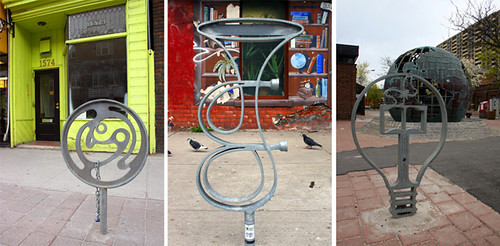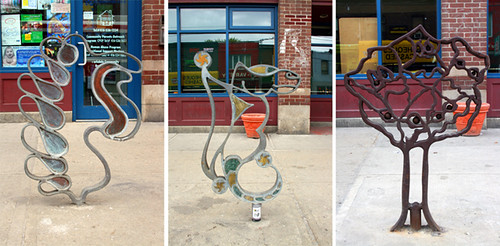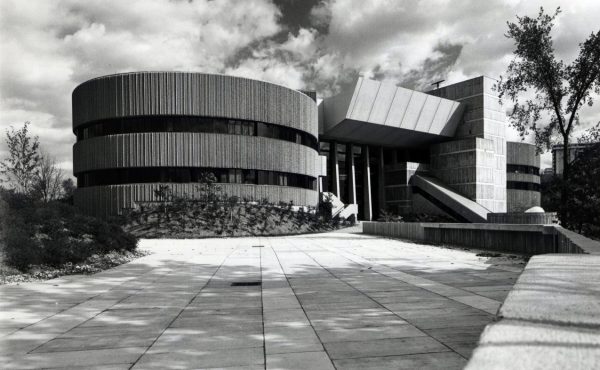

The first time I saw Parkdale’s new bike posts, or “bike rack sculptures” according to their creators, I immediately though how boring and unoriginal the ring and post models were. Why didn’t city officials create something interesting in the first place? Since the Parkdale posts have gone up several others have sprouted elsewhere in the city. From the original Parkdale BIA press release in April 2007:
Along with crocuses, roses and tulips that are emerging in gardens across Toronto, a crop of unique and functional public art is springing up in Parkdale.
Known as bike rack sculptures, these colourful and creative elements of street furniture are sprouting in various locations in Parkdale, taking the form of a tree, butterfly, gargoyle and other inventive shapes and designs. Four racks have already popped up at 1499 Queen St. W. in front of Parkdale Activity Recreation Centre (PARC), a community centre offering support to psychiatric survivors and people who are socially isolated. Ten additional racks will be installed at the Parkdale Village Business Improvement Area office (PVBIA) on Queen Street West between Dufferin Street and Roncesvalles Avenue. To view the bike rack sculptures already in place, visit: www.parkdalevillagebia.com

The bike rack sculpture program has helped to strengthen the relationship between the property owners, businesses and members of PVBIA and the marginalized and psychiatric survivors who live in the community. Local artist Phil Sarazen worked with members of PARC to design the racks; members of the Meeting Place, an adult drop-in centre operated by St. Christopher House, welded metal into the eye-catching racks that are starting to make a big impact on the streets. The program has helped to give a sense of pride and ownership of the streetscape to members of PARC and the Meeting Place.
“The process to develop the racks have proved to be a great way for residents, business owners and the broader community to work together to create a positive identity for the neighbourhood and strengthen community pride,” Bridget Vianna, Chair of the Parkdale Liberty Economic Development Corporation. “It has given our community members the ability to explore their creativity, beautify the local streetscape while serving a function by adding bicycle parking capacity to the area.”
The bike rack sculpture program was developed by the Parkdale Village Business Improvement Area and the Parkdale Liberty Economic Development Corporation. The program was made possible with a grant from City of Toronto’s Economic Development Office through the Economic Development Mural Program. The City of Toronto will also install the racks, all of which will be unveiled at an event to be held on Monday, April 16, 2007 at 11:00am in front of the Parkdale Library at 1303 Queen Street West at Cowan Avenue.

photos by Shaun Merritt.


18 comments
Although many of these are really nice (as are similar ones in different areas of the city), I really like the plain-jane ring and posts as well, aesthetically. There’s something reassuring about seeing miles and miles of them about town.
And as for being unoriginal, weren’t they the first ring-and-post designs around? (I think Jack Layton claims to have come up with them…)
I agree with Andrew. Yes, the Parkdale and now ROM bikeracks are fresh and whimsical, but the ‘Post and Ring’ is a classic Toronto design emulated around the world. They’ve been around for decades now and have helped provide us with more bike parking than any other City in North America.
Clarification: Jack might have been at the table when the discussion took place, but a City industrial designer at the time is really the one who developed the concept–back in the day when we could afford to do such projects without falling back on corporate partnerships such as the Astral Media Street Furnishing program. We likely won’t look back on our new shelters,cans and benches as fondly.
I would add that locking up and getting some Amico’s to go is one of my favourite Parkdale things.
I forgot to add how cost effective the post and ring design really is. You can get about 7 or 8 of the “boring non-original” bike racks for the cost of one of the Parkdale versions. Try budgeting that over a City the size of Toronto that right now has over 15,000 bike rings and adds over a 1000 every year.
Shaun: sometimes you just have to find beauty in simplicity. The post and ring was designed as a response to the program at hand. Could City officials have come up with something more decorative? Sure, but at what cost.
These are all great designs, but I can’t imagine filling the city with thousands of copies of any of them. You really do need something simple and functional for mass installation, which allows these to delight by being different and unexpected.
What I like about the ring-and-post racks is that through years of use I know exactly the best way to quickly position my locks to minimize the possibility of theft or the bike falling down. With the new (but admittedly pretty) racks, there will be a learning curve with every new design.
These are all excellent points but BARAY touches on something very important – money. The debate over how much money should be spent on public art must be very, very old. One can find examples of public art in Mesopotamia, thousands of years old, and we can be sure not everyone agreed on how much should be spent, or how many resources should be devoted to creating it.
How much money and resources should go into creating public art? How do we calculate the benefits, if any? The debate will probably never end.
I don’t think the post is about making individual racks all over the city, but that certain areas of neighbourhoods can implement them whenever appropirate. You can also make attractive bike racks that can be mass produced. One of the few good pieces in the Atral street furniture proposal was a graceful u-shape. It was cut from the final roll-out.
This is all not to say I don’t like the ring and post. I love them, but a variety of bike racks, for different spaces and uses, would be ideal.
Hmm. I find a beautiful simplicity in the ring-and-post. It’s so efficient in form and shape. Our streets would look too busy with anything that demands more attention.
Shaun: My point on expenditure was not in respect to public art; it was to the point of street furniture. Two very different things altogether. I live in Parkdale and certainly appreciate the new bike racks. But as you can see from the other comments, like and love for the post and ring design is quite common.
Reminded of David Byrne’s bike racks for the NYC Dept. of Transportation – http://www.davidbyrne.com/art/bike_racks/index.php.
I like the simplicity of the ring and post racks.
If they weren’t beside regular bike racks to give them context, I’d never know what they were supposed to be.
The ring and post bike lock up was designed by David Dennis – the above mentioned city industrial designer.
To me, we have the best of both worlds – the simple and extremely easy to use ring and posts, which like other posters I like a lot – and the occassional variation, as in Parkdale and near the ROM. Seems about perfect to me.
While its nice to have a few of these around, it would be terrible to have them replace the standard ring and posts.
I love the photo but wished you could have included the entire little car in the frame.
Amico’s is my favourite restaurant in Parkdale!
Nice post. Coincidentally I blogged about bike sculptures in Parkdale few days back. Here is the link http://priyank.com/travel/2009/04/07/toronto-tuesday-0110/
Several new bike racks have since been installed. I like my neighborhood. 🙂
cheers, Priyank.
Here in Burlington, Vermont, we have several instances of bike-lock sculptures. One of my favorite is shaped as a bike lock itself. While I confess I find many of the systems less functional than standard bicycle racks, bring art and aesthetics into our attemp to green the planet and promote sustainability is essential. As part of the Ecological Design program here at the University of Vermont, I was fortunate to take classes with ecological designer John Todd, and architect and community planner Diane Gayer. Both of these teachers find amazing ways to blend beauty into form and function. Incidentally, the Ecological Design program is offering some neat summer courses this year on community planning, ecovillages, and recreation trail design – if you are interested in learning more, visithttp://learn.uvm.edu/igs/ecological_design